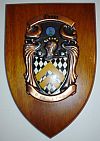Sir
Andrew Wood lived from about 1450 to 1538. He was an admiral in the Royal Scots Navy who has been described as "Scotland's
Nelson". The wider picture in Scotland at the time is set out in our Historical
Timeline.
Andrew
Wood was born in Upper
Largo
in Fife.
He first came to note as a sea captain and merchant based in Leith. In time he came to own two ships, the Flower
and the Yellow Caravel. These he used to trade with ports in the Netherlands and the Baltic. For trading vessels they
were unusually well equipped and armed, and it is clear Wood was also an active privateer, effectively a legalised pirate,
preying on the shipping of Scotland's enemies: and England ships in particular. During the 1480s, Wood was appointed to become
the personal sea captain to James
III, and was obliged to ensure the Yellow Caravel was available for the use of the King and
Queen. In return he was granted estates around Largo
in Fife.
In
1488 he carried James
III
and his supporters up the Forth to Stirling
in advance of the Battle of Sauchieburn, after which James
was killed in mysterious circumstances. Wood quickly transferred his allegiances to the young James
IV.
Later in 1488 Wood really came to prominence when with his two ships he surprised and captured five English privateers which
had been attacking Scottish ships off Dunbar.
Wood was knighted by James
IV as a result. Henry VII of England responded by offering £1,000 a year for life to any English captain who could
capture Wood. The challenge was accepted by Sir Stephen Bull, who sailed into the Forth with three of the most powerful ships
then available in England. In the battle that followed, Sir Andrew Wood and his two ships, despite being outgunned, won the
day.
Sir
Andrew was given the rank of admiral in the rapidly expanding Royal Scots Navy, a service which dated back for at least four
centuries, but which only really flowered under James
IV.
Having seen off the English privateers, Wood supported James
IV's
ambitions to bring the clans of the Hebrides and western seaboard under control after the final demise of the Lord
of the Isles in 1493.
After
its launch at Newhaven in 1511, Sir Andrew took command of the Great Michael. The flagship
of the Royal Scots Navy was said to be the largest ship in Europe and cost £30,000. She weighed 1,000 tons, was 240ft (73m)
long, and had a crew of over 1,100. Sir Andrew Wood subsequently commanded the Scottish fleet that supported the French against
the English in 1513. After the disastrous Battle
of Flodden in 1513, in which the Scottish army was wiped out by the
English, the Great Michael was sold to the French
and Sir Andrew spent some time as Scotland's Ambassador to France.
On
returning to Scotland Sir Andrew briefly served as Regent for the young James
V
before retiring to his estates in Fife.
In 1488 he had married Elizabeth Lundie, and they had a number of sons. In 1491 he had built a family home in the form of
a fortified tower house (or fortalice) a quarter of a mile to the west of Upper
Largo,
according to some sources on the site of a much older castle. He is said to have surrounded this by a moat. He then built
what is believed to be Scotland's earliest canal to connect his home with the medieval church at Upper
Largo. This can still in places be traced on the ground, though only a single tower of the fortalice he built still
stands and the old church has since been replaced. Sir Andrew was said to have hated travelling by land, and had a barge on
which he was rowed to church each Sunday. He made his final journey to be buried in this way after his death: though accounts
differ as to when he died, ranging from as early as 1515 to as late as 1539.

